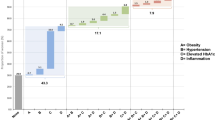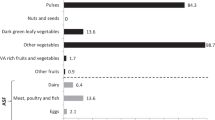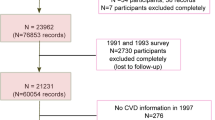Abstract
Background
High body iron status has been associated with non-communicable diseases (NCD) like diabetes (high fasting blood glucose, FBG), hypertension (HTN) or dyslipidaemia (high total cholesterol, TC) in adults, but this has not been examined in adolescent children. This is relevant to iron supplementation and food iron fortification programs that are directed at Indian children.
Methods
The association of NCD with Serum Ferritin (SF) was examined using logistic additive models, adjusted for confounders such as age, body mass index, C-Reactive Protein, haemoglobin and sex, in adolescent (10–19 years old) participants of the Indian Comprehensive National Nutrition Survey. The interaction of these associations with wealth and co-existing prediabetes was also examined. A scenario analysis was also done to understand the impact of iron fortification of cereals on the prevalence NCD among adolescents.
Results
The odds ratio (OR) of high FBG, HTN and TC were 1.05 (95% CI: 1.01–1.08), 1.02 (95% CI: 1.001–1.03) and 1.04 (95% CI: 1.01–1.06) respectively for every 10 µg/L increase in SF. The odds for high TC increased with co-existing prediabetes. The scenario analysis showed that providing 10 mg of iron/day by fortification could increase the prevalence of high FBG by 2–14% across states of India. Similar increments in HTN and TC can also be expected.
Conclusions
High SF is significantly associated with NCD in adolescents, dependent on wealth and co-existing prediabetes. This should be considered when enhancing iron intake in anaemia prevention programs, and the NCD relationship with body iron stores should be studied.
This is a preview of subscription content, access via your institution
Access options
Subscribe to this journal
Receive 12 print issues and online access
$259.00 per year
only $21.58 per issue
Buy this article
- Purchase on Springer Link
- Instant access to full article PDF
Prices may be subject to local taxes which are calculated during checkout



Similar content being viewed by others
Data availability
This was a secondary analysis on the CNNS data, which are the property of the Ministry of Health and Family Welfare, Government of India.
References
Swaminathan S, Fonseca VA, Alam MG, Shah SV. The role of iron in diabetes and Its complications. Diabetes Care. 2007;30:1926–33.
Simcox JA, McClain DA. Iron and diabetes risk. Cell Metab. 2013;17:329–41.
Ford ES, Cogswell ME. Diabetes and serum ferritin concentration among U.S. adults. Diabetes Care. 1999;22:1978–83.
Jiang L, Wang K, Lo K, Zhong Y, Yang A, Fang X, et al. Sex-specific association of circulating ferritin level and risk of type 2 diabetes: a dose-response meta-analysis of prospective studies. J Clin Endocrinol Metab. 2019;104:4539–51.
Lee DH, Kang SK, Choi WJ, Kwak KM, Kang D, Lee SH, et al. Association between serum ferritin and hypertension according to the working type in Korean men: the fifth Korean National Health and nutrition examination survey 2010-2. Ann Occup Environ Med. 2018;30:40.
Kim YE, Kim DH, Roh YK, Ju SY, Yoon YJ, Nam GE, et al. Relationship between serum ferritin levels and dyslipidemia in Korean adolescents. PLoS One. 2016;11:e0153167.
Valko M, Leibfritz D, Moncol J, Cronin MT, Mazur M, Telser J. Free radicals and antioxidants in normal physiological functions and human disease. Int J Biochem Cell Biol. 2007;39:44–84.
Chatterjee P. India’s child malnutrition story worsens. Lancet Child Adolesc Health. 2021;5:P319–20.
Anemia Mukt Bharat. Intensified National Iron Plus Initiative (INIPI) [Internet]. New Delhi, India: Ministry of Health and Family Welfare, Government of India; 2020 Available from: https://anemiamuktbharat.info/wp-content/uploads/2019/09/Anemia-Mukt-Bharat-Brochure_English.pdf [accessed 13 September, 2021].
Kurpad AV, Ghosh S, Thomas T, Bandyopadhyay S, Goswami R, Gupta A, et al. Perspective: When the cure might become the malady: the layering of multiple interventions with mandatory micronutrient fortification of foods in India. Am J Clin Nutr. 2021;114:1261–6.
Street A. Food as pharma: marketing nutraceuticals to India’s rural poor. Crit Public Health. 2015;25:361–72.
India State-Level Disease Burden Initiative Diabetes Collaborators. The increasing burden of diabetes and variations among the states of India: the Global Burden of Disease Study 1990–2016. Lancet Glob Health. 2018;6:e1352–e1362.
Gupta R, Gaur K, Ram CV. Emerging trends in hypertension epidemiology in India. J Hum Hypertens. 2019;33:575–87.
Gupta R, Rao RS, Misra A, Sharma SK. Recent trends in epidemiology of dyslipidemias in India. Indian Heart J. 2017;69:382–92.
Ministry of Health and Family Welfare (MoHFW), Government of India, UNICEF and Population Council. Comprehensive National Nutrition Survey (CNNS). National Report 2016–2018. New Delhi, India: MoHFW, Government of India, UNICEF and Population Council; 2019 [accessed 13 September, 2021].
Sachdev HS, Porwal A, Sarna A, Acharya R, Ramesh S, Kapil U, et al. Intraindividual double-burden of anthropometric undernutrition and “metabolic obesity” in Indian children: a paradox that needs action. Eur J Clin Nutr. 2021;75:1205–17.
Pullakhandam R, Peter R, Ghosh S, Reddy GB, Kulkarni B, Thomas T, et al. Prevalence of low serum zinc concentrations in Indian children and adolescents: findings from the Comprehensive National Nutrition Survey 2016-18. Am J Clin Nutr. 2021;114:638–48.
Sachdev HS, Porwal A, Acharya R, Ashraf S, Ramesh S, Khan N, et al. Haemoglobin thresholds to define anaemia in a national sample of healthy children and adolescents aged 1-19 years in India: a population-based study. Lancet. Glob Health. 2021;9:e822–e831.
American Diabetes Association. Diagnosis and classification of diabetes mellitus. Diabetes Care. 2010;33:S62–9.
Expert Panel on Integrated Guidelines for Cardiovascular Health and Risk Reduction in Children and Adolescents; National Heart, Lung, and Blood Institute. Expert panel on integrated guidelines for cardiovascular health and risk reduction in children and adolescents: summary report. Pediatrics 2011;128:S213–S256.
National High Blood Pressure Education Program Working Group on High Blood Pressure in Children and Adolescents. The fourth report on the diagnosis, evaluation, and treatment of high blood pressure in children and adolescents. Pediatrics. 2004;114:555–76.
National Sample Survey Office. Nutritional intake in India: 2011–12, NSS 68th round. New Delhi: National Statistical Organization, Government of India; 2014.
Thimmayamma BVS, Rau P, Damayanti K. Dietary assessment as part of nutritional status. In: Bamji MS, Krishnaswamy K, Brahmam GNV, editors. Textbook of human nutrition. 4th ed. New Delhi (India): Oxford & IBH Publishing Pvt Ltd.; 2016:121–51.
Muthayya S, Thankachan P, Hirve S, Amalrajan V, Thomas T, Lubree H, et al. Iron fortification of whole wheat flour reduces iron deficiency and iron deficiency anemia and increases body iron stores in Indian school-aged children. J Nutr. 2012;142:1997–2003.
Moretti D, Zimmermann MB, Muthayya S, Thankachan P, Lee TC, Kurpad AV, et al. Extruded rice fortified with micronized ground ferric pyrophosphate reduces iron deficiency in Indian schoolchildren: a double-blind randomized controlled trial. Am J Clin Nutr. 2006;84:822–9.
The Gazette of India: Extraordinary. Part II—Section 4. Food safety and standards (fortification of foods) regulations 2018. Notification. New Delhi, India: Government of India; 2018.
Kim MK, Baek KH, Song K-H, Kang MI, Choi JH, Bae JC, et al. Increased serum ferritin predicts the development of hypertension among middle-aged men. Am J Hypertens 2012;25:492–7.
Jiang R, Manson JE, Meigs JB, Ma J, Rifai N, Hu FB. Body iron stores in relation to risk of type 2 diabetes in apparently healthy women. JAMA 2004;291:711–7.
Trayhurn P, Wood IS. Signalling role of adipose tissue: adipokines and inflammation in obesity. Biochem Soc Trans. 2005;33:1078–81.
Gabrielsen JS, Gao Y, Simcox JA, Huang J, Thorup D, Jones D, et al. Adipocyte iron regulates adiponectin and insulin sensitivity. J Clin Invest. 2012;122:3529–40.
Houschyar KS, Ludtke R, Dobos GJ, Kalus U, Broecker-Preuss M, Rampp T, et al. Effects of phlebotomy induced reduction of body iron stores on metabolic syndrome: results from a randomized clinical trial. BMC Med. 2012;10:54.
Auvinen J, Tapio J, Karhunen V, Kettunen J, Serpi R, Dimova EY, et al. Systematic evaluation of the association between hemoglobin levels and metabolic profile implicates beneficial effects of hypoxia. Sci Adv. 2021;7:eabi4822.
Zhang X, Wu M, Zhong C, Huang L, Zhang Y, Chen R, et al. Association between maternal plasma ferritin concentration, iron supplement use, and the risk of gestational diabetes: a prospective cohort study. Am J Clin Nutr. 2021;21:nqab162 https://doi.org/10.1093/ajcn/nqab162.
Sparano S, Ahrens W, De Henauw S, Marild S, Molnar D, Moreno LA, et al. Being macrosomic at birth is an independent predictor of overweight in children: results from the IDEFICS study. Matern Child Health J. 2013;17:1373–81.
Walter PB, Knutson MD, Paler-Martinez A, Lee S, Xu Y, Viteri FE, et al. Iron deficiency and iron excess damage mitochondria and mitochondrial DNA in rats. Proc Natl Acad Sci USA. 2002;99:2264–9.
Department of Food and Public Distribution. Centrally sponsored pilot scheme on “fortification of rice & its distribution under Public Distribution System” [Internet]. New Delhi, India: Department of Food and Public Distribution, Government of India; 2021 [accessed 3 May, 2021]. Available from: https://dfpd.gov.in/Centrally_Sponsored_Pilot_Scheme.htm.
The Gazette of India: Extraordinary. Part II—Section 4. Food safety and standards (fortification of foods) regulations 2018. Notification. New Delhi, India: Government of India; 2018.
Acknowledgements
HSS and AVK are recipients of the Wellcome Trust/Department of Biotechnology India Alliance Clinical/Public Health Research Centre Grant # IA/CRC/19/1/610006.
Funding
These secondary analyses and manuscript were not supported by any specific funding. The CNNS was conducted by the Ministry of Health and Family Welfare, Government of India, and the UNICEF, with financial support from the Mittal Foundation.
Author information
Authors and Affiliations
Contributions
HSS and AVK conceived the idea, guided the analysis and drafted the manuscript. SG and TT conducted all statistical analyses. All authors were involved during drafting and approved the final manuscript. All authors had access to raw data.
Corresponding authors
Ethics declarations
Competing interests
HSS designed the draft protocol of the CNNS with consultancy support from the UNICEF, India. HSS and AVK were members of the Technical Advisory Committee of the CNNS, constituted by the Ministry of Health and Family Welfare of the Government of India, to oversee its conduct and analysis. HSS is a member of the World Health Organization Nutrition Guidance Expert Advisory Subgroup on Diet and Health. HSS and AVK are members of Expert Groups of the Ministry of Health and Family Welfare on Nutrition and Child Health, and the National Technical Board on Nutrition of the Niti Ayog, Government of India.
Ethical approval
No separate ethical approval was required for this secondary analysis. The CNNS was conducted according to the guidelines laid down in the Declaration of Helsinki and all procedures involving human subjects were approved by the Population Council’s International Review Board (New York, USA) and ethics committee of Post Graduate Institute of Medical Education and Research (Chandigarh, India).
Additional information
Publisher’s note Springer Nature remains neutral with regard to jurisdictional claims in published maps and institutional affiliations.
Rights and permissions
Springer Nature or its licensor (e.g. a society or other partner) holds exclusive rights to this article under a publishing agreement with the author(s) or other rightsholder(s); author self-archiving of the accepted manuscript version of this article is solely governed by the terms of such publishing agreement and applicable law.
About this article
Cite this article
Ghosh, S., Thomas, T., Kurpad, A. et al. Is iron status associated with markers of non-communicable disease in adolescent Indian children?. Eur J Clin Nutr 77, 173–181 (2023). https://doi.org/10.1038/s41430-022-01222-2
Received:
Revised:
Accepted:
Published:
Issue Date:
DOI: https://doi.org/10.1038/s41430-022-01222-2



